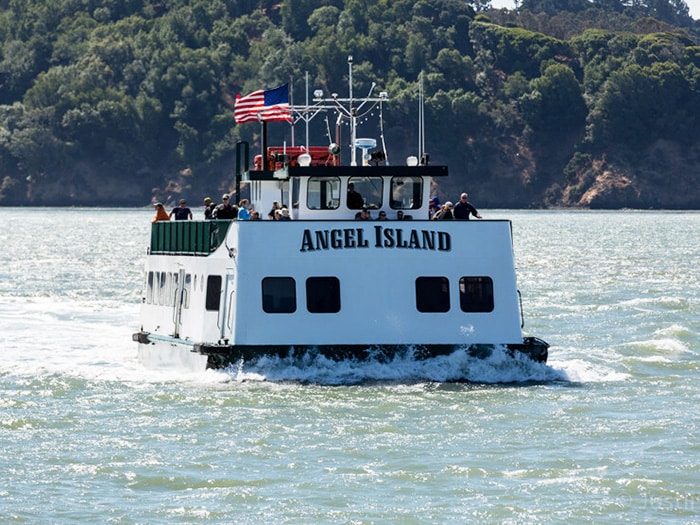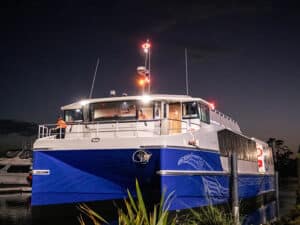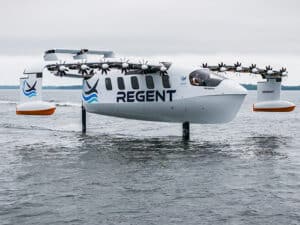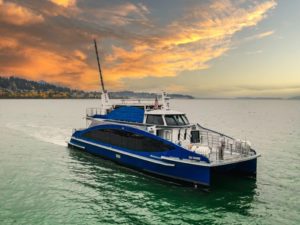
California’s Angel Island ferry to be converted to all-electric
Written by Nick Blenkey
The 1975-built, 400-passenger ferry Angel Island is set for all-electric operation in 2024
Pacific Gas and Electric Company (PG&E) is partnering with the Angel Island-Tiburon Ferry Company (Angel Island Ferry) to support the electrification of its 400-passenger, 1975-built ferry vessel Angel Island which plans to operate as California’s first zero-emission, electric propulsion short-route ferry beginning in 2024.
The electrification project marks a milestone for PG&E’s Electric Vehicle (EV) Fleet Program by expanding its support of transportation electrification to include the marine sector.
“The Angel Island ferry is an important part of California history and Bay Area tourism, carrying hundreds of thousands of visitors to Angel Island State Park for nearly a half-century. We are excited to support and collaborate on its conversion to an electric propulsion vessel,” said Lydia Krefta, PG&E’s director for clean energy transportation. “For years, PG&E has been leading the way toward California’s clean energy transportation future and supporting our customers as they electrify their vehicle fleets. This partnership marks a significant expansion of our resources beyond land-based electric vehicles, and it demonstrates how we deliver for our hometowns and in support of California’s clean energy goals.”
PG&E says that its EV Fleet Program helps medium- and heavy-duty fleet customers easily and cost-effectively install charging infrastructure via comprehensive construction support and financial incentives. Through the collaboration with Angel Island Ferry, PG&E plans to bolster electricity transmission to the ferry terminal and support the installation of charging infrastructure to help power the 59-foot, 400-passenger vessel for its ferry service, sunset cruises and chartered events.
“We are very excited that the Angel Island will be the first of the short-run ferries in California to be 100% zero-emission, as our company continues supporting the natural environment of the Bay and our beautiful state park,” said Captain Maggie McDonogh, fourth-generation owner and operator of the Angel Island ferry. “Getting adequate electricity to our ferry terminal is an essential part of this plan. We could not move forward with going electric without the important support we receive as a participant in PG&E’s EV Fleet Program. It shows that PG&E supports small family-owned businesses like ours that are trying to reduce emissions.”
California-based Green Yachts has been selected to convert the Angel Island to electric propulsion. Green Yachts says its mission is to decarbonize the marine sector and advance the electric revolution on the water. It is dedicated to the sale and servicing of electric boats and converting commercial and recreational vessels to electric propulsion and is the first marine sector authorized dealer in California’s CORE (Clean Offroad Equipment) program.
“This electrification project wouldn’t be possible without sufficient electrical supply for fast charging between ferry runs. PG&E has been a great partner throughout the collaboration,” said Graham Balch, managing broker of Green Yachts. “An electric semi-truck requires 2 kWh to go one mile, and the Angel Island requires 30 kWh to go one mile. The increased energy requirement per mile shows the significant challenge associated with electrifying the marine sector.”
“The electrification of the Angel Island vessel aligns with our core focus of proactively preparing the grid for the future, increasing access to charging infrastructure, and supporting electric transportation adoption through rates, rebates, tools, and education,” said Aaron August, PG&E’s vice president, utility partnerships and innovation. “PG&E is committed to providing easy-to-use and affordable clean transportation programs and incentives that help redefine the energy landscape to support California’s clean air and greenhouse gas emission reduction goals and collective action on climate change.”
All of this raises the question, “how green is the electricity that will power the Angel Island?” According to the company, which is a a subsidiary of PG&E Corporation [NYSE:PCG], the power mix delivered to its bundled-service customers in 2021 included the following greenhouse gas-free technologies:
- Non-emitting nuclear generation (39%)
- Large hydroelectric facilities (4%)
- Eligible renewable resources, such as wind, geothermal, biomass, solar and small hydro (50%)




